NUR 507quiz 1 GRADED A
Document Content and Description Below
After sexual transmission of HIV, a person can be infected yet seronegative for months. Student Answer: 1 to 2 6 to 14 18 to 20 24 to 36 Instructor Exp... lanation: Antibody appears rather rapidly after infection through blood products, usually within 4 to 7 weeks. After sexual transmission, however, the individual can be infected yet seronegative for 6 to 14 months or, in at least one case, for years. Points Received: 0 of 2 Comments: Question 2.Question : What of the following remains a significant cause of morbidity and mortality worldwide? Student Answer: Starvation Traumatic injury Cardiovascular disease Infectious disease Instructor Explanation: Despite the wide scale implementation of progressive public health and immunization policies, infectious disease remains a significant cause of morbidity and mortality. Points Received: 2 of 2 Comments: Question 3.Question : Once they have penetrated the first line of defense, which microorganisms do neutrophils actively attack, engulf, and destroy by phagocytosis? Student Answer: Bacteria Fungi Viruses Mycoplasma Instructor Explanation: Invasion results in direct confrontation with an individual’s primary defense mechanisms against bacteria, which include the complement system, antibodies, and phagocytes, such as neutrophils and macrophages. (See Chapters 6, 7, and 8). Points Received: 2 of 2 Comments: Question 4.Question : Cells in may act as a reservoir in which HIV can be relatively protected from antiviral drugs. Student Answer: the central nervous system bone marrow the thymus gland the lungs Instructor Explanation: HIV may persist in regions where the antiviral drugs are not as effective, such as the CNS. Points Received: 2 of 2 Comments: Question 5.Question : Which statement is true about fungal infections? Student Answer: They occur only on skin, hair, and nails. They are controlled by phagocytes and T lymphocytes. They result in release of endotoxins. They are prevented by vaccines. Instructor Explanation: The host defense against fungal infection includes the fungistatic properties of neutrophils and macrophages. T lymphocytes are crucial in limiting the extent of infection and producing cytokines to further activate macrophages. Points Received: 2 of 2 Comments: Question 6.Question : What is the role of reverse transcriptase in HIV infection? Student Answer: It converts single DNA into double-stranded DNA. It is needed to produce integrase. It transports the RNA into the cell nucleus. It converts RNA into double-stranded DNA. Instructor Explanation: One particular family of viruses, retroviruses (e.g., HIV) carries an enzyme reverse transcriptase that creates a double-stranded DNA version of the virus. Points Received: 2 of 2 Comments: Question 7.Question : What is the mechanism in type II hypersensitivity reactions? Student Answer: Antibodies coat mast cells by binding to receptors that signal its degranulation followed by discharge of preformed mediators. Antibodies bind to soluble antigens that were released into body fluids and the immune complexes are deposited in the tissues. Cytotoxic T lymphocytes or lymphokines-producing Th1 cells attack and destroy cellular targets directly. Antibodies bind to the antigens on the cell surface. Instructor Explanation: All of these mechanisms begin with antibody binding to tissue-specific antigens or antigens that have attached to particular tissues. First, the cell can be destroyed by antibody (IgG or IgM) and activation of the complement cascade through the classical pathway. Points Received: 2 of 2 Comments: Question 8.Question : In a type II hypersensitivity reaction, when soluble antigens from infectious agents enter circulation, tissue damage is a result of Student Answer: complement-mediated cell lysis. phagocytosis by macrophages. phagocytosis in the spleen. neutrophil granules and toxic oxygen products. Instructor Explanation: The components of neutrophil granules, as well as the several toxic oxygen products produced by these cells, damage the tissue. Points Received: 0 of 2 Comments: Question 9.Question : What disease involves the deposition of circulating immune complexes containing an antibody against host DNA, resulting in tissue damage? Student Answer: fic anemia Pernicious anemia Systemic lupus erythematosus (SLE) Myasthenia gravis Instructor Explanation: Deposition of circulating immune complexes containing antibody against DNA produces tissue damage in individuals with SLE. Points Received: 2 of 2 Comments: Question 10.Question : In which primary immune deficiency is there a partial to complete absence of T-cell immunity? Student Answer: Bruton disease DiGeorge syndrome Reticular dysgenesis Adenosine deaminase (ADA) deficiency Instructor Explanation: The principal immunologic defect in DiGeorge syndrome is the partial or complete absence of T-cell immunity. Points Received: 2 of 2 Comments: Question 11. Question : During an IgE-mediated hypersensitivity reaction, what causes bronchospasm? Student Answer: Bronchial edema caused by chemotactic factor of anaphylaxis Bronchial edema caused by binding of the cytotropic antibody Smooth muscle contraction caused by histamine bound to H1 receptors Smooth muscle contraction caused by histamine bound to H2 Instructor Explanation: receptors Acting through the H1 receptors, histamine contracts bronchial smooth muscles, causing bronchial constriction; increases vascular permeability, causing edema; and causes vasodilation, increasing blood flow into the affected area (Figures 6-3 and 6-10). Points Received: 2 of 2 Comments: Question 12.Question : Deficiencies in which element can produce depression of both B- and T- cell function? Student Answer: Iron Zinc Iodine Magnesium Instructor Explanation: Deficient zinc intake can profoundly depress T- and B-cell function. Points Received: 2 of 2 Comments: Question 13.Question : What is the mechanism in type III hypersensitivity reactions? Student Answer: Antibodies coat mast cells by binding to receptors that signal its degranulation followed by discharge of preformed mediators. Antibodies bind to soluble antigens that were released into body fluids and the immune complexes are deposited in the tissues. Cytotoxic T lymphocytes or lymphokine-producing Th1 cells attack and destroy cellular targets directly. Antibodies bind to the antigen on the cell surface. Instructor Explanation: Most type III hypersensitivity diseases are caused by antigen-antibody (immune) complexes that are formed in the circulation and deposited later in vessel walls or extravascular tissues (Figure 8-3). Points Received: 2 of 2 Comments: Question 14.Question : Exhaustion occurs if stress continues and is not successful. Student Answer: flight or fight alarm adaptation arousal Instructor Explanation: Exhaustion occurs if stress continues and adaptation is not successful, ultimately causing impairment of the immune response, heart failure, and kidney failure, leading to death. Points Received: 2 of 2 Comments: Question 15.Question : During a stress response, increased anxiety, vigilance, and arousal is prompted by Student Answer: norepinephrine. epinephrine. cortisol. ACTH. Instructor Explanation: Norepinephrine release promotes arousal, increased vigilance, increased anxiety, and other protective emotional responses. Points Received: 0 of 2 Comments: Question 16.Question : Stress-induced norepinephrine results in Student Answer: decreased blood flow to the brain and skin. peripheral vasoconstriction. increased glycogen synthesis in the liver. decreased muscle contraction as a result of an energy depletion. Instructor Explanation: Norepinephrine regulates blood pressure by constricting smooth muscle in all blood vessels. During stress, norepinephrine raises blood pressure by constricting peripheral vessels. Points Received: 0 of 2 Comments: Question 17.Question : Stress-age syndrome results in decreased Student Answer: catecholamines. ACTH. cortisol. immune system. Instructor Explanation: Immunodepression is one of the characteristic changes seen in stress-age syndrome. Points Received: 2 of 2 Comments: Question 18.Question : What is the role of vascular endothelial growth factor (on), basic fibroblast growth factor (bFGF), and transforming growth factor-alpha (TGF-) in cell metastasis? Student Answer: To stimulate growth of nearby tumor cells To develop new blood vessels to feed cancer cells To prevent cancer cells from escaping apoptosis To act as a chemical gradient to guide cells to blood vessels Instructor Explanation: The angiogenic factors, such as VEGF, platelet-derived growth factor (PDGF), transforming growth factor-alpha (TGF-), and growth factor bFGF, by recruiting new vascular endothelial cells and initiating the proliferation of existing blood vessel cells, allow small cancers to become large cancers. Points Received: 2 of 2 Comments: Question 19.Question : Intestinal polyps are benign neoplasms and the first stage in development of colon cancer. These findings support the notion that Student Answer: cancers of the colon are more easily diagnosed in the benign form because they can be visualized during colonoscopy. an accumulation of mutations in specific genes is required for the development of cancer. tumor invasion and metastasis progress more slowly in the gastrointestinal tract. apoptosis is triggered by diverse stimuli including excessive growth. Instructor Explanation: It is understood that multiple genetic mutations are required for the evolution of full-blown cancer. The remaining options do not address the progression of benign to metastatic tumors. Points Received: 2 of 2 Comments: Question 20.Question : In chronic myeloid leukemia (CML), a piece of chromosome 9 fuses to a piece of chromosome 22. This is an example of which mutation of normal genes to oncogenes? Student Answer: Point mutation Chromosome fusion Gene amplification Chromosome translocation Instructor Explanation: Chromosome translocations, in which a piece of one chromosome is translocated to another chromosome, can activate oncogenes. In a different type of leukemia, CML, a specific chromosome translocation is almost always present. The remaining options are not best depicted by CML. Points Received: 2 of 2 Comments: Question 21.Question : Which of the following represents the correct nomenclature for benign and malignant tumors of adipose tissue, respectively? Student Answer: Liposarcoma, lipoma Lipoma, liposarcoma Adisarcoma, adipoma Adipoma, adisarcoma Instructor Explanation: In general, cancers are named according to the cell type from which they originate (e.g., lip), whereas benign tumors use the suffix “-oma.” Points Received: 2 of 2 Comments: Question 22.Question : Which of the viruses below are f DNA viruses? Student Answer: Papovaviruses, adenoviruses, and herpesviruses Retroviruses, papovaviruses, and adenoviruses Adenoviruses, herpesviruses, and retroviruses Herpesviruses, retroviruses, and papovaviruses Instructor Explanation: Papovaviruses, adenoviruses, and herpesviruses are oncogenic DNA viruses; the remaining examples do not fall into this category. Points Received: 2 of 2 Comments: Question 23.Question : Many cancers create a mutation of ras. What is ras? Student Answer: A tumor-suppressor gene A growth-promoting gene An intracellular signaling protein that regulates cell growth A cell surface receptor that allows signaling to the nucleus about cell Instructor Explanation: growth Up to one third of all cancers have an activating mutation in the gene for an intracellular signaling protein called ras. This mutant ras stimulates cell growth even when growth factors are missing. The remaining options do not describe ras. Points Received: 0 of 2 Comments: Question 24.Question : Which characteristic among women correlates with a high morbidity of cancer of the colon, liver, gallbladder, pancreas, breast, uterus, and kidney? Student Answer: Women older than 45 years of age Women who never had children Women who had a high body mass index Woman who smoked for more than 10 years Instructor Explanation: A recent hypothesis states that the observed increased incidence of such cancers as breast, endometrium, colon, liver, kidney, and adenomas of the esophagus may be associated with obesity. There are no current data to support the remaining options. Points Received: 0 of 2 Comments: Question 25.Question : What congenital malformation is commonly linked to acute leukemia in children? Student Answer: Down syndrome Wilms tumor Retinoblastoma Neuroblastoma Instructor Explanation: Trisomy 21 (Down syndrome) is the most common genetic defect linked to the development of acute leukemia. Children with Down syndrome have a 10- to 20-fold increased risk of developing acute lymphoblastic and myelogenous leukemia and a higher risk for developing acute megakaryocytic leukemia. There are no current data to support a link between the other stated congenital malformations and acute leukemia. Points Received: 2 of 2 Comments: * Times are displayed in (GMT-07:00) Mountain Time (US & Canada) Grading Summary These are the automatically computed results of your exam. Grades for essay questions, and comments from your instructor, are in the "Details" section below. Date Taken: 5/6/2017 Time Spent: 12 min , 50 secs Points Received: 42 / 50 (84%) Question Type: # Of Questions: # Correct: Multiple Choice 25 21 Grade Details - All Questions Question 1.Question : What is the role of reverse transcriptase in HIV infection? Student Answer: It converts single DNA into double-stranded DNA. It is needed to produce integrase. It transports the RNA into the cell nucleus. It converts RNA into double-stranded DNA. Instructor Explanation: One particular family of viruses, retroviruses (e.g., HIV) carries an enzyme reverse transcriptase that creates a double-stranded DNA version of the virus. Points Received: 2 of 2 Comments: Question 2.Question : Once they have penetrated the first line of defense, which microorganisms do neutrophils actively attack, engulf, and destroy by phagocytosis? Student Answer: Bacteria Fungi Viruses Mycoplasma Instructor Explanation: Invasion results in direct confrontation with an individual’s primary defense mechanisms against bacteria, which include the complement system, antibodies, and phagocytes, such as neutrophils and macrophages. (See Chapters 6, 7, and 8). Points Received: 2 of 2 Comments: Question 3.Question : Which statement about vaccines is true? Student Answer: Most bacterial vaccines contain attenuated organisms. Most viral vaccines are made by using dead organisms. Vaccines require booster injections to maintain lifelong protection. Vaccines provide effective protection for all people against viruses, Instructor Explanation: bacteria, and fungal infections. In general, vaccine-induced protection does not persist as long as infection- induced immunity, thus booster injections may be necessary to maintain protection throughout life. Points Received: 2 of 2 Comments: Question 4.Question : Which statement is true about fungal infections? Student Answer: They occur only on skin, hair, and nails. They are controlled by phagocytes and T lymphocytes. They result in release of endotoxins. They are prevented by vaccines. Instructor Explanation: The host defense against fungal infection includes the fungistatic properties of neutrophils and macrophages. T lymphocytes are crucial in limiting the extent of infection and producing cytokines to further activate macrophages. Points Received: 2 of 2 Comments: Question 5.Question : What of the following remains a significant cause of morbidity and mortality worldwide? Student Answer: Starvation Traumatic injury Cardiovascular disease Infectious disease Instructor Explanation: Despite the wide scale implementation of progressive public health and immunization policies, infectious disease remains a significant cause of morbidity and mortality. Points Received: 2 of 2 Comments: Question 6.Question : After sexual transmission of HIV, a person can be infected yet seronegative for months. Student Answer: 1 to 2 6 to 14 18 to 20 24 to 36 Instructor Explanation: Antibody appears rather rapidly after infection through blood products, usually within 4 to 7 weeks. After sexual transmission, however, the individual can be infected yet seronegative for 6 to 14 months or, in at least one case, for years. Points Received: 2 of 2 Comments: Question 7.Question : Deficiencies in which element can produce depression of both B- and T- cell function? Student Answer: Iron Zinc Iodine Magnesium Instructor Explanation: Deficient zinc intake can profoundly depress T- and B-cell function. Points Received: 2 of 2 Comments: Question 8.Question : What disease involves the deposition of circulating immune complexes containing an antibody against host DNA, resulting in tissue damage? Student Answer: Hemolytic anemia Pernicious anemia Systemic lupus erythematosus (SLE) Myasthenia gravis Instructor Explanation: Deposition of circulating immune complexes containing antibody against DNA produces tissue damage in individuals with SLE. Points Received: 2 of 2 Comments: Question 9.Question : During an IgE-mediated hypersensitivity reaction, what causes bronchospasm? Student Answer: Bronchial edema caused by chemotactic factor of anaphylaxis Bronchial edema caused by binding of the cytotropic antibody Smooth muscle contraction caused by histamine bound to H1 receptors Smooth muscle contraction caused by histamine bound to H2 Instructor Explanation: receptors Acting through the H1 receptors, histamine contracts bronchial smooth muscles, causing bronchial constriction; increases vascular permeability, causing edema; and causes vasodilation, increasing blood flow into the affected area (Figures 6-3 and 6-10). Points Received: 2 of 2 Comments: Question 10.Question : What is the mechanism in type II hypersensitivity reactions? Student Answer: Antibodies coat mast cells by binding to receptors that signal its degranulation followed by discharge of preformed mediators. Antibodies bind to soluble antigens that were released into body fluids and the immune complexes are deposited in the tissues. Cytotoxic T lymphocytes or lymphokines-producing Th1 cells attack and destroy cellular targets directly. Antibodies bind to the antigens on the cell surface. Instructor Explanation: All of these mechanisms begin with antibody binding to tissue-specific antigens or antigens that have attached to particular tissues. First, the cell can be destroyed by antibody (IgG or IgM) and activation of the complement cascade through the classical pathway. Points Received: 2 of 2 Comments: Question 11. Question : Hypersensitivity is best defined as a(n) Student Answer: disturbance in the immunologic tolerance of self-antigens. immunologic reaction of one person to the tissue of another person. altered immunologic response to an antigen that results in disease. undetectable immune response in the presence of antigens. Instructor Explanation: Hypersensitivity is an altered immunologic response to an antigen that results in disease or damage to the host. Points Received: 0 of 2 Comments: Question 12.Question : A person with type O blood is likely to have high titers of anti- antibodies. Student Answer: A B A and B O Instructor Explanation: Type O individuals, who have neither A or B antigen but have both anti-A and anti- B antibodies, cannot accept blood from any of the other three types. Points Received: 2 of 2 Comments: Question 13.Question : The class of antibody involved in type I hypersensitivity reactions is Student Answer: IgA. IgE. IgG. IgM. Instructor Explanation: Type I reactions are mediated by antigen-specific IgE and the products of tissue mast cells (see Figure 8-1). Points Received: 2 of 2 Comments: Question 14.Question : Exhaustion occurs if stress continues and is not successful. Student Answer: flight or fight alarm adaptation arousal Instructor Explanation: Exhaustion occurs if stress continues and adaptation is not successful, ultimately causing impairment of the immune response, heart failure, and kidney failure, leading to death. Points Received: 2 of 2 Comments: Question 15.Question : What effect does estrogen have on lymphocytes? Student Answer: Depression of B cells and enhancement of T cells Depression of T cells and enhancement of B cells Depression of B cells and T cells Enhancement of B cells and T cells Instructor Explanation: Estrogens generally are associated with a depression of T-cell–dependent immune function and enhancement of B-cell functions. Points Received: 2 of 2 Comments: Question 16.Question : Stress-age syndrome results in decreased Student Answer: catecholamines. ACTH. cortisol. immune system. Instructor Explanation: Immunodepression is one of the characteristic changes seen in stress-age syndrome. Points Received: 2 of 2 Comments: Question 17.Question : During a stress response, increased anxiety, vigilance, and arousal is prompted by Student Answer: norepinephrine. epinephrine. cortisol. ACTH. Instructor Explanation: Norepinephrine release promotes arousal, increased vigilance, increased anxiety, and other protective emotional responses. Points Received: 0 of 2 Comments: Question 18.Question : Which cytokine is involved in producing cachexia syndrome? Student Answer: Interleukin-1 (IL-1) Colony-stimulating factor (CSF) Tumor necrosis factor (TNF) Interleukin-15 (IL-15) Instructor Explanation: Cytokines, including TNF-, IL-6, and interferon-, appear to cause the metabolic alterations associated with tissue loss in cancer wasting. Points Received: 2 of 2 Comments: Question 19.Question : Inherited mutations that predispose to cancer are almost invariably what kind of gene? Student Answer: Proto-oncogenes Oncogenes Tumor-suppressor genes Growth-promoting genes Instructor Explanation: These inherited mutations that predispose to cancer are almost invariably in tumor- suppressor genes. At present there are no data to support the other options as factors related to how inherited mutations cause cancer. Points Received: 0 of 2 Comments: Question 20.Question : Intestinal polyps are benign neoplasms and the first stage in development of colon cancer. These findings support the notion that Student Answer: cancers of the colon are more easily diagnosed in the benign form because they can be visualized during colonoscopy. an accumulation of mutations in specific genes is required for the development of cancer. tumor invasion and metastasis progress more slowly in the gastrointestinal tract. apoptosis is triggered by diverse stimuli including excessive growth. Instructor Explanation: It is understood that multiple genetic mutations are required for the evolution of full-blown cancer. The remaining options do not address the progression of benign to metastatic tumors. Points Received: 2 of 2 Comments: Question 21.Question : Many cancers create a mutation of ras. What is ras? Student Answer: A tumor-suppressor gene A growth-promoting gene An intracellular signaling protein that regulates cell growth A cell surface receptor that allows signaling to the nucleus about cell Instructor Explanation: growth Up to one third of all cancers have an activating mutation in the gene for an intracellular signaling protein called ras. This mutant ras stimulates cell growth even when growth factors are missing. The remaining options do not describe ras. Points Received: 2 of 2 Comments: Question 22.Question : By what process does the ras gene convert from a proto-oncogene to an oncogene? Student Answer: By designating a chromosome that has a piece of one chromosome fused to a piece of another chromosome By duplicating a small piece of a chromosome, repeatedly making numerous copies By alternating one or more nucleotide base pairs By promoting proliferation of growth signals by impairing tumor- Instructor Explanation: suppressor genes A point mutation is the alteration of one or a few nucleotide base pairs. This type of mutation can have profound effects on the activity of proteins. A point mutation in the ras gene converts it from a regulated proto-oncogene to an unregulated oncogene, an accelerator of cellular proliferation. The remaining options do not describe point mutation as it affects the conversion of a ras gene. Points Received: 0 of 2 Comments: Question 23.Question : In chronic myeloid leukemia (CML), a piece of chromosome 9 fuses to a piece of chromosome 22. This is an example of which mutation of normal genes to oncogenes? Student Answer: Point mutation Chromosome fusion Gene amplification Chromosome translocation Instructor Explanation: Chromosome translocations, in which a piece of one chromosome is translocated to another chromosome, can activate oncogenes. In a different type of leukemia, CML, a specific chromosome translocation is almost always present. The remaining options are not best depicted by CML. Points Received: 2 of 2 Comments: Question 24.Question : Tobacco smoking is associated with cancers of all of the following except Student Answer: lung. skin. bladder. kidney. pancreas. Instructor Explanation: Smoking causes cancer of the lung and is associated with cancers of the renal gland, bladder, penis, oral cavity, pharynx, larynx, nasal cavities, sinuses, esophagus, stomach, liver, kidney, uterus, and myeloid leukemia. There are no data currently linking the tobacco smoking skin cancer. Points Received: 2 of 2 Comments: Question 25.Question : What percentage of children with cancer can be cured? Student Answer: 40% 50% 60% 70% Instructor Explanation: Currently, more than 70% of children diagnosed with cancer are cured. Points Received: 2 of 2 Comments: * Times are displayed in (GMT-07:00) Mountain Time (US & Canada) [Show More]
Last updated: 2 years ago
Preview 1 out of 21 pages
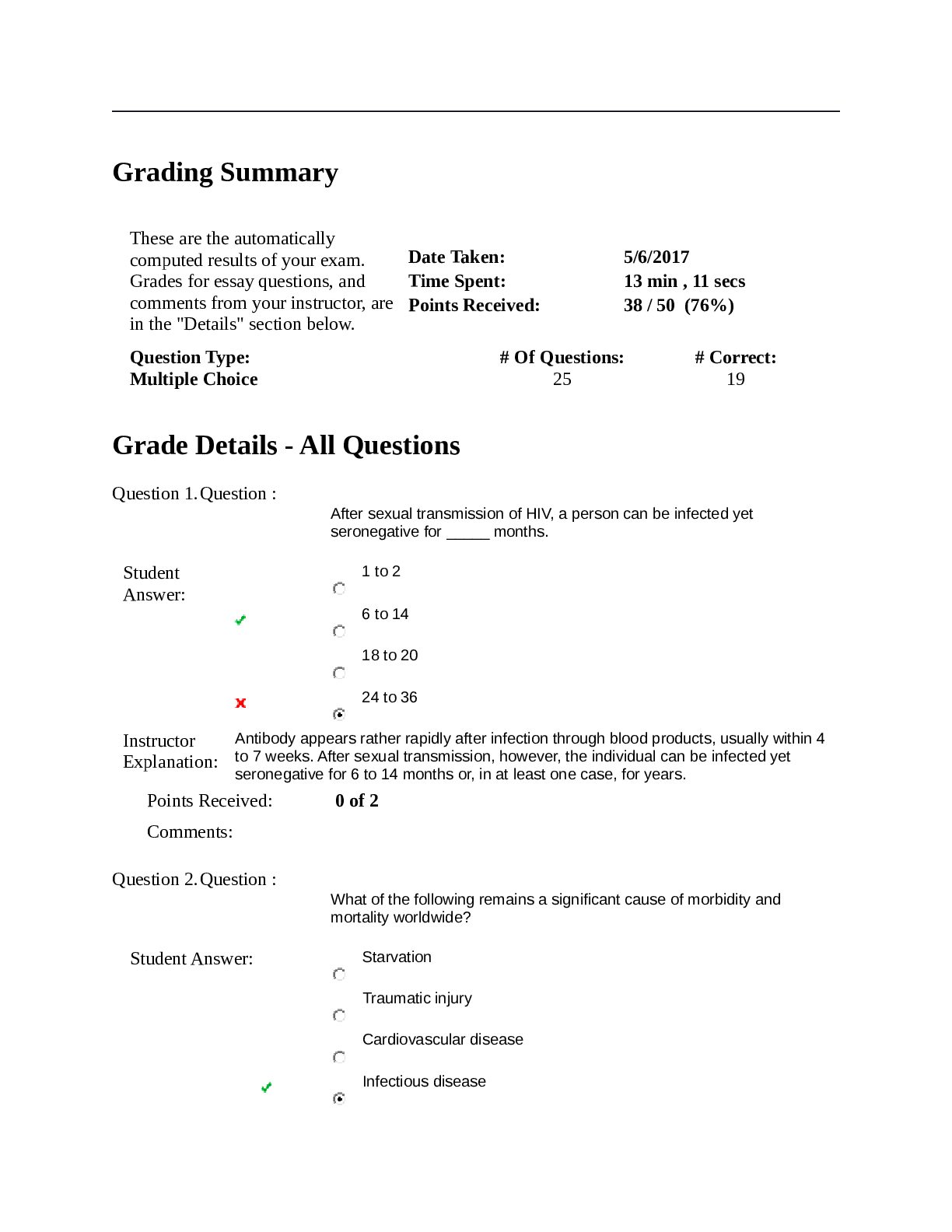
Buy this document to get the full access instantly
Instant Download Access after purchase
Buy NowInstant download
We Accept:

Reviews( 0 )
$9.00
Can't find what you want? Try our AI powered Search
Document information
Connected school, study & course
About the document
Uploaded On
Apr 02, 2021
Number of pages
21
Written in
Additional information
This document has been written for:
Uploaded
Apr 02, 2021
Downloads
0
Views
61

.png)

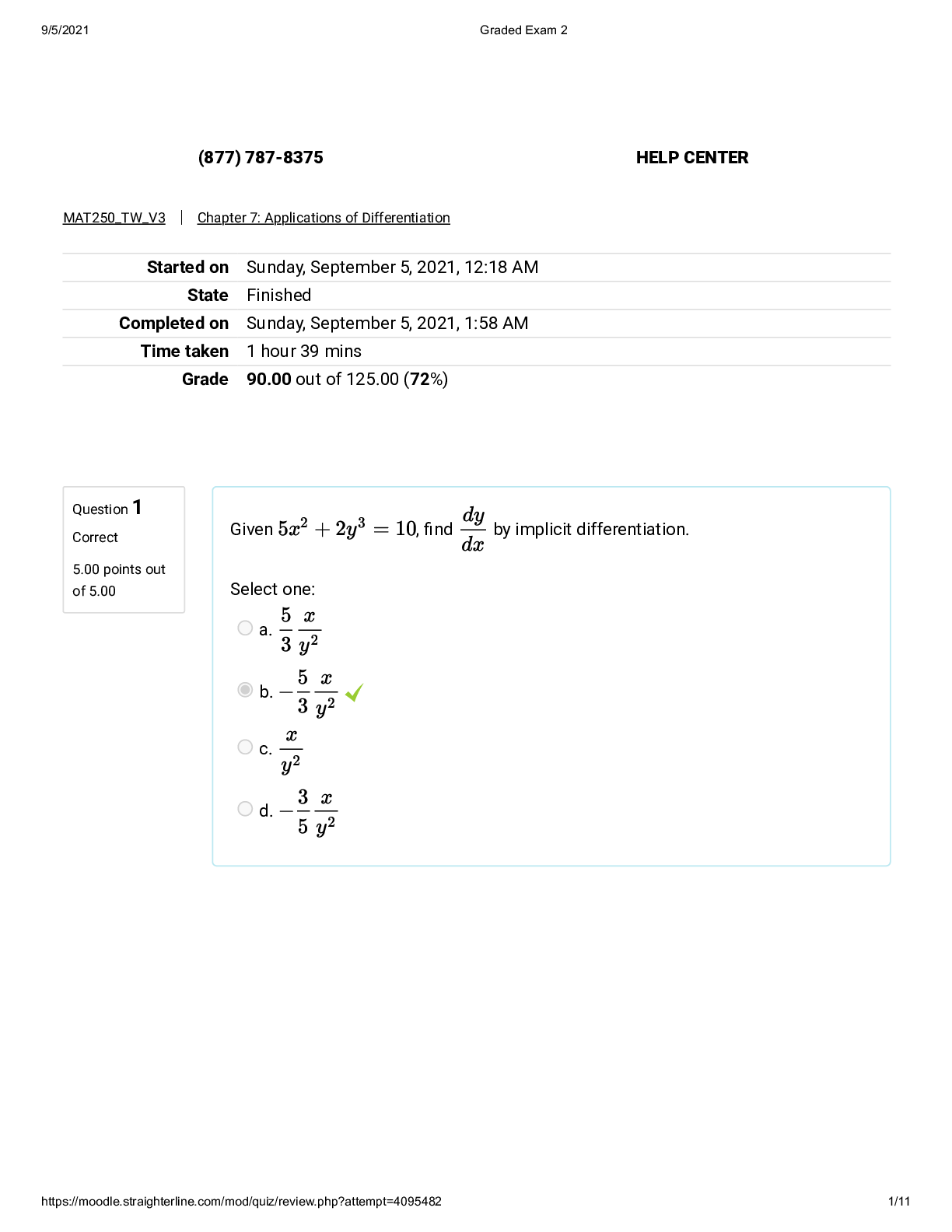
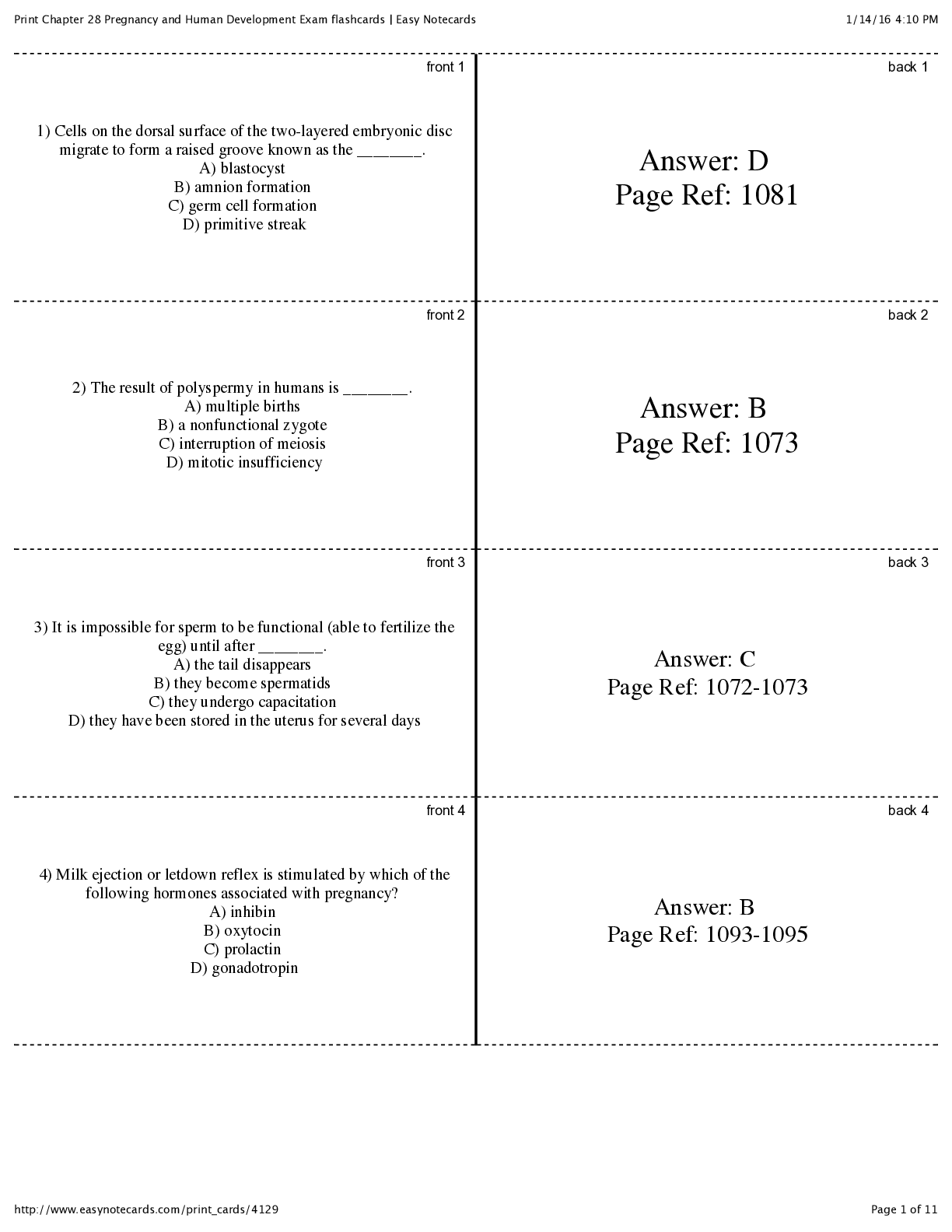


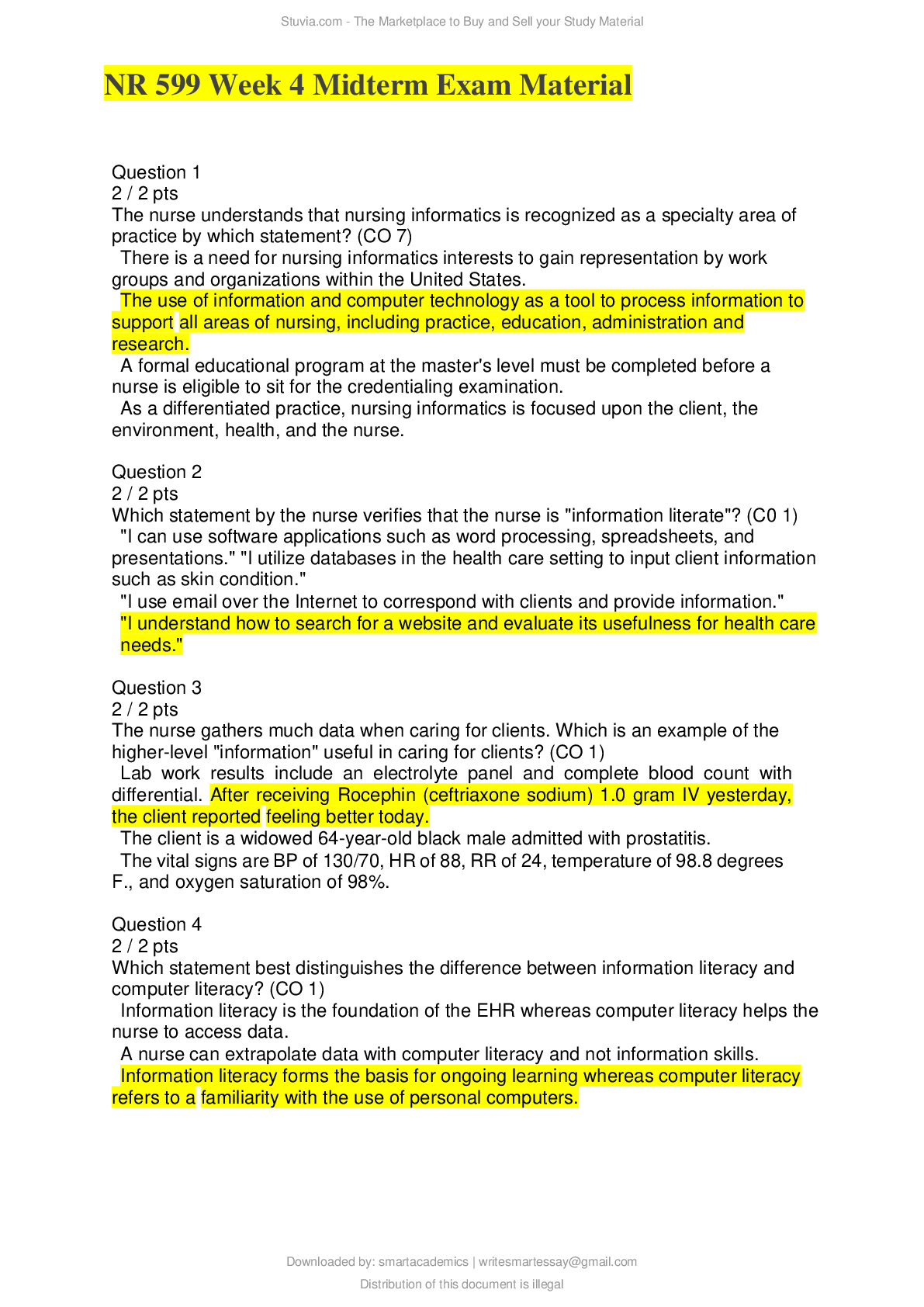

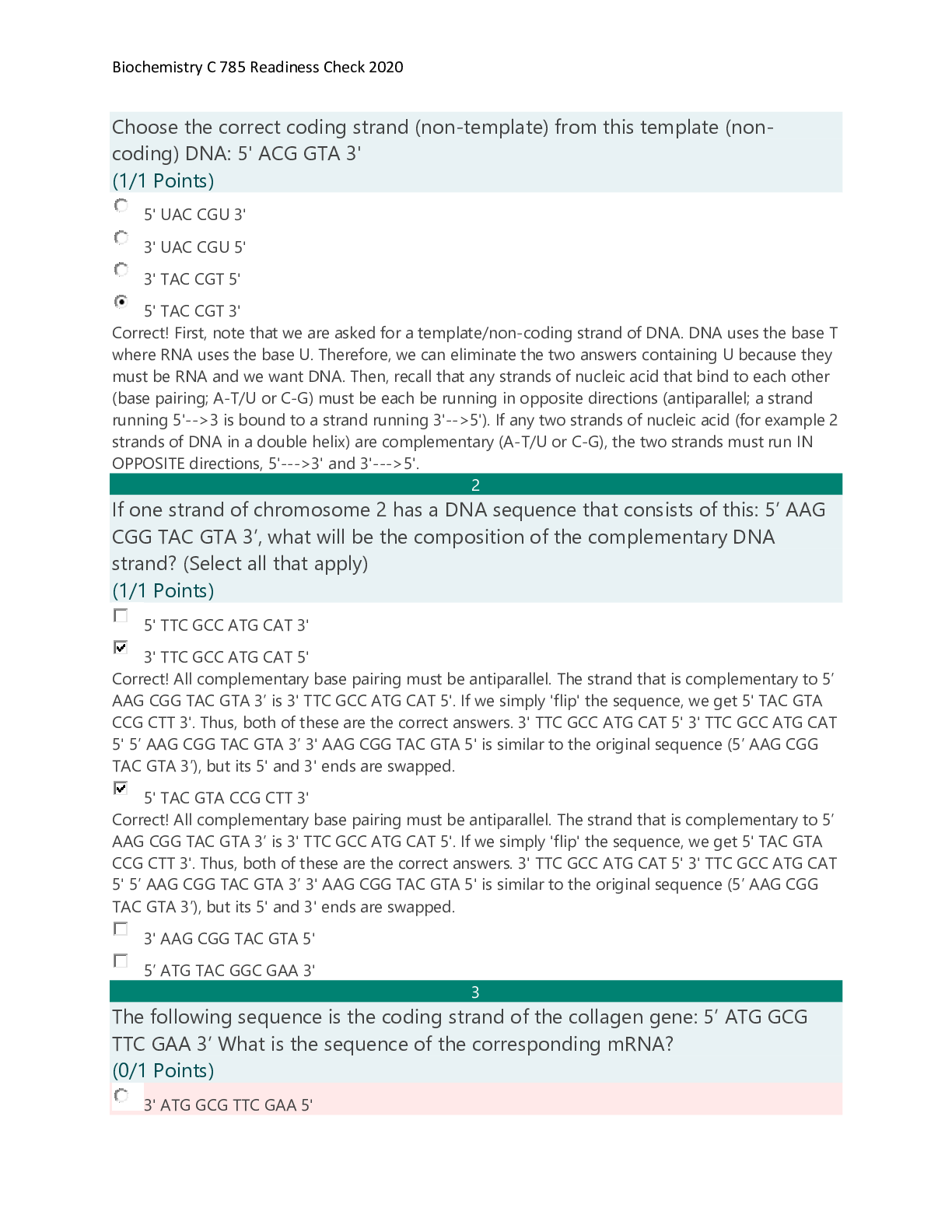
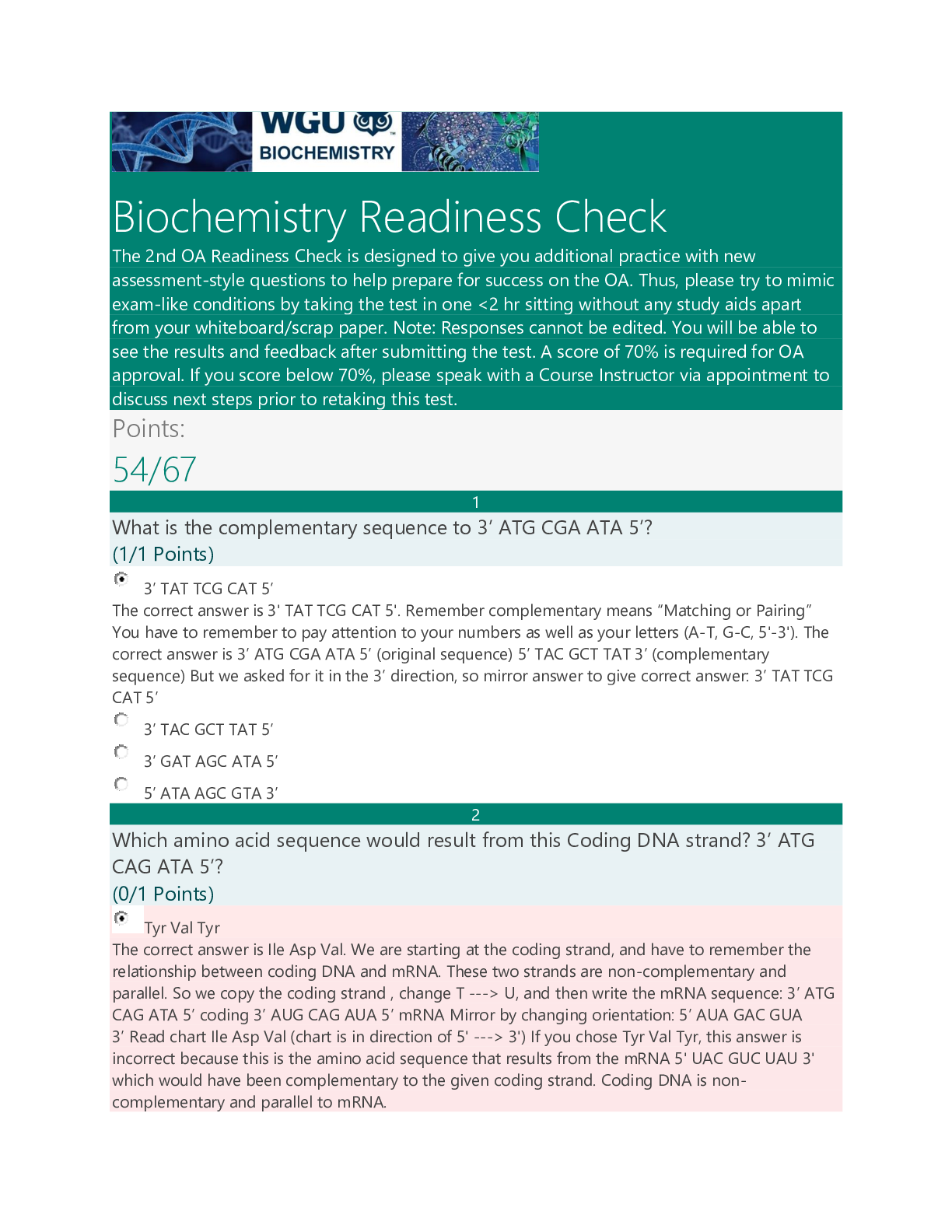

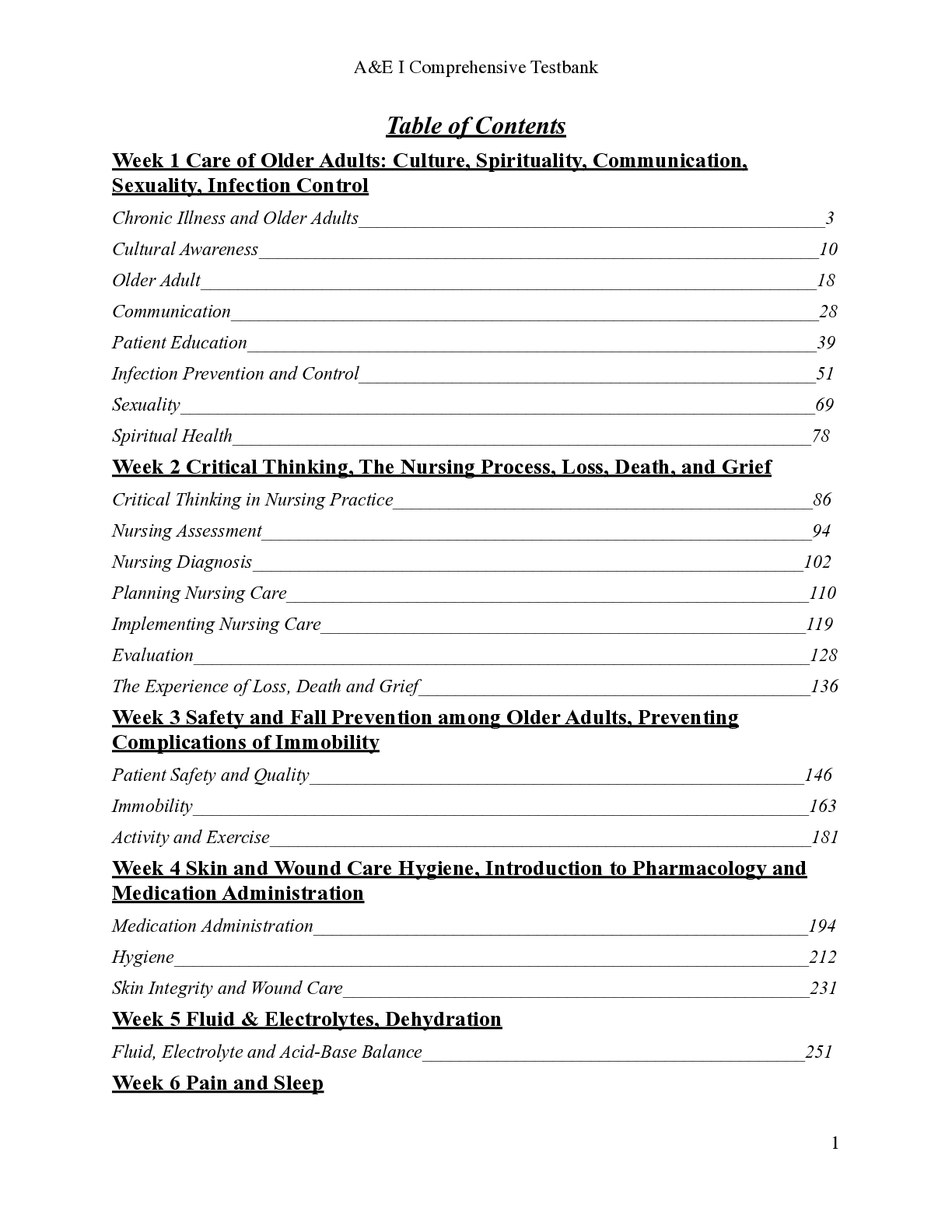



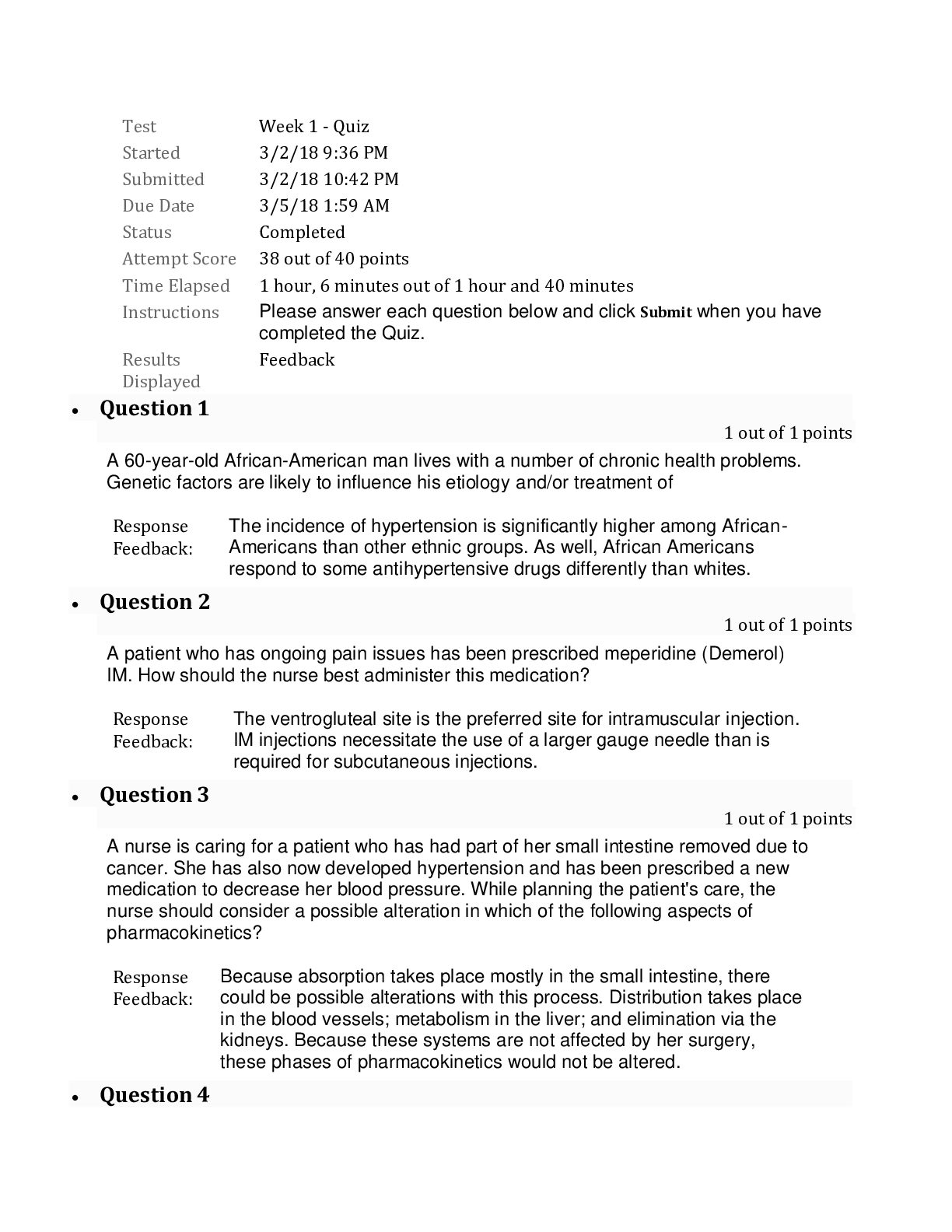




.png)
.png)
.png)


